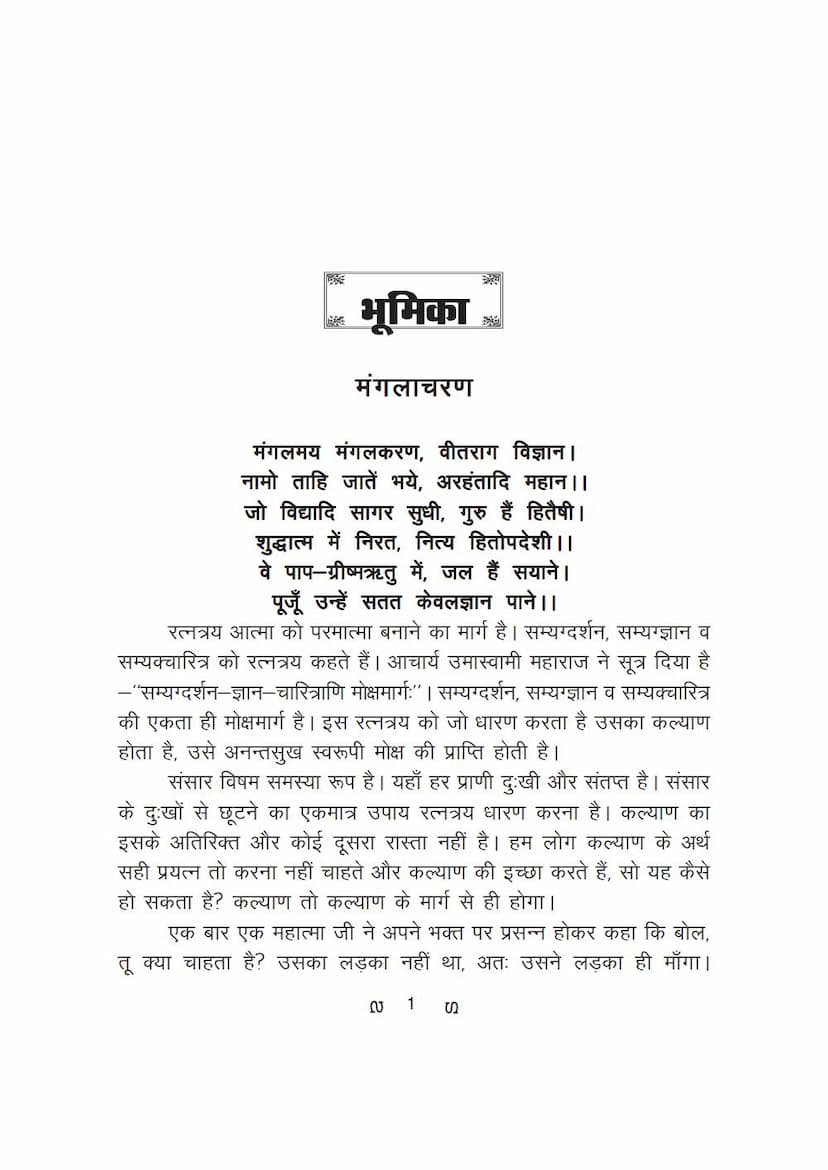Ratnatraya Part 01
Added to library: September 2, 2025

Summary
This comprehensive summary of "Ratnatraya Part 01" by Surendra Varni elucidates the core Jain concept of Ratnatraya (Three Jewels) as the path to liberation (Moksha). The text emphasizes that the unity of Samyagdarshan (Right Faith), Samyagjñāna (Right Knowledge), and Samyakcharitra (Right Conduct) constitutes the path to Moksha, leading to eternal happiness.
Key Themes and Concepts:
- The Nature of Suffering and Liberation: The text begins by describing the worldly existence as inherently filled with suffering and dissatisfaction. It asserts that the only way to escape these sufferings and attain liberation (Moksha) is by adhering to the Ratnatraya.
- The Importance of Ratnatraya:
- Samydarshan (Right Faith): This is presented as the fundamental jewel. It is the correct understanding and belief in the true nature of reality, particularly the soul (Jiva) as distinct from the non-soul (Ajeeva). The text highlights that believing in wrong principles (Mithyatva) is the root of all suffering, while Right Faith is the root of all welfare. It defines Right Faith as understanding oneself as the soul, distinct from the body and other external substances. The text provides analogies to illustrate how attachment to external objects leads to suffering, similar to a child's futile desire to put an elephant in his pocket.
- Samyagjñāna (Right Knowledge): This is the correct and complete knowledge of the soul, soul's qualities, and the nature of reality as presented in Jain scriptures. It involves dispelling ignorance and understanding the distinction between the self (soul) and the non-self (body, senses, external objects, karma).
- Samyakcharitra (Right Conduct): This is the practice of living in accordance with Right Faith and Right Knowledge. It involves ethical conduct, self-discipline, and adherence to vows and principles, leading to the cessation of karmic influx and the eventual shedding of accumulated karma.
- The Path to Real Happiness: The book strongly asserts that true and eternal happiness lies not in worldly possessions or sensory pleasures but within the soul itself. The path to this inner happiness is through understanding and practicing the Ratnatraya.
- Critique of Worldly Attachments: The text repeatedly warns against attachment to worldly things like wealth, family, body, and sensory pleasures, identifying them as the root cause of suffering and rebirth. Analogies like the story of the elephant and the child, or the musk deer seeking fragrance outside itself, illustrate the futility of searching for happiness externally.
- The Power of Right Faith (Samyagdarshan): The first part of the book focuses heavily on Samyagdarshan, explaining its meaning, importance, and the detrimental effects of its absence (Mithyatva). It quotes scriptures and verses from revered Acharyas like Umāsvāmi, Samantabhadra, and Shubachandra to emphasize its supreme significance.
- The Seven Tattvas (Principles): The book systematically introduces and explains the seven fundamental Jain principles: Jiva (soul), Ajeeva (non-soul), Asrava (influx of karma), Bandha (bondage of karma), Samvara (cessation of karma influx), Nirjara (shedding of karma), and Moksha (liberation). It clarifies the incorrect beliefs (Mithyatva) related to these principles.
- The Stages of Spiritual Development: The text implicitly describes the progression from Bahirātmā (soul engrossed in externals) to Antarātmā (soul realizing its true nature) and finally to Paramātmā (liberated soul).
- The Role of Devotion and Practice: The book highlights the importance of devotion to the true Tirthankaras (Deva), scriptures (Shastra), and virtuous preceptors (Guru) as crucial external aids in the journey towards Right Faith. It also emphasizes the need for consistent practice and adherence to spiritual disciplines.
- The Inherent Nature of the Soul: The soul is described as intrinsically pure, blissful, and possessing infinite knowledge and power. The suffering experienced is due to the soul's ignorance of its true nature and its entanglement with karmas.
- The Rarity of Human Birth: The human birth is considered extremely precious and rare, offering the unique opportunity for spiritual progress and liberation. It is therefore emphasized that this opportunity should not be wasted in pursuit of fleeting worldly pleasures.
- The Eight Angas of Samyagdarshan: The text elaborates on the eight essential qualities or limbs of Right Faith: Nishankita (doubtlessness), Nishankshita (unwavering desire for liberation), Nirvichikitsa (without disgust), Amudhadrishti (unwavering perspective), Upaguhan (concealing faults of others, manifesting one's own faults), Sthitikaran (stabilizing others in faith), Vatsalya (compassion/affection for fellow beings), and Prabhavana (spreading the glory of Jainism).
- The Path of Renunciation and Detachment: The core message revolves around detachment from worldly desires and the cultivation of a pure, self-aware state of being, leading to the ultimate goal of Moksha.
In essence, "Ratnatraya Part 01" serves as a foundational text for understanding the Jain path to liberation, meticulously explaining the foundational principles of Right Faith, Knowledge, and Conduct, and urging the reader to internalize these teachings for their ultimate spiritual well-being. The book is rich with parables and analogies, making complex philosophical concepts accessible to the reader.